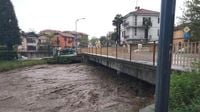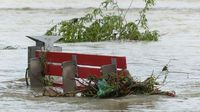On April 16, 2025, a severe weather system swept through Piedmont, Italy, prompting authorities to issue a "red" alert for the province of Turin and parts of the surrounding areas. The regional weather agency, Arpa Piemonte, classified the event as one of the most intense weather waves seen in the last decade, with meteorologist Andrea Vuolo emphasizing its severity. The alert indicates the likelihood of floods, landslides, and avalanches, particularly affecting the Alpine regions between Val di Susa and Canavese, along with parts of Biella and Vercelli.
As heavy rainfall began to drench Turin and its surroundings, the worst was predicted to arrive during the night and extend into the following morning. The Prefecture responded by activating the Centro Coordinamento Soccorsi, which includes representatives from law enforcement, rescue associations, and local governments. Additionally, the regional government opened the Sala operativa della Protezione civile to coordinate necessary interventions.
In Turin, the local government also initiated its Centro operativo comunale, mobilizing volunteers to monitor the Po and other rivers. Local authorities closed the Murazzi area along the river and prohibited any activities on the water, urging residents to limit their movements to essential travel only.
By the evening of April 16, the Sesia River in Borgosesia had already exceeded safety thresholds, and forecasts indicated that many tributaries of the Po were expected to surpass these levels by April 17. The bulletin from Arpa Piemonte warned of a progressive rise in the tributaries due to significant rainfall from the Orco, Stura di Lanzo, and Dora Riparia basins, which would elevate water levels downstream of Turin.
In particular, the sections of the Po at San Sebastiano and Crescentino were anticipated to reach critical levels. The Tanaro River was also monitored closely, with expectations of moderate criticality on April 17.
Rainfall measurements from Arpa Piemonte indicated that Sambughetto Valstrona, located at 742 meters in Verbano, received over 300 millimeters of rain in the past 24 hours. In the province of Turin, the Forzo station reported 233 millimeters, highlighting the intensity of the downpour.
As the weather system continued to impact the region, authorities advised against any high-altitude activities. Reports indicated that over 40 centimeters of fresh snow had already fallen above 2,500 meters, with forecasts suggesting that totals could exceed two meters by the end of the storm. The avalanche risk was deemed to be between "strong" and "very strong," prompting the Piedmont Alpine Rescue Service to warn residents to stay indoors.
As conditions worsened, the alerts were updated throughout April 17. The weather forecast indicated cloudy skies with moderate rainfall in the eastern sectors and heavy rainfall in the west, particularly in mountainous and pre-mountain areas. Snow levels were expected to drop to around 1700-1900 meters, with local variations down to 200-300 meters during intense weather events.
In response to the escalating situation, the regional government announced the opening of the Civil Protection operations room to monitor rainfall and prepare for potential safety measures in the most vulnerable municipalities. The Prefect convened the Centro Coordinamento Soccorsi to coordinate efforts.
In the Turin area, firefighters were dispatched to clear roads blocked by fallen branches and trees. Notably, in Strambino, firefighters rescued two men whose car was swept into the Dora River by strong currents.
By the evening of April 16, the A5 Turin-Aosta highway was closed in the direction of Turin due to a landslide in Quincinetto, an area that has been under surveillance for years. To mitigate traffic disruptions, the northbound lane was opened for two-way traffic.
In Chivasso, Mayor Claudio Castello signed an urgent ordinance in response to the critical hydrogeological situation, prohibiting access to riverbanks and closing local parks. The ordinance aimed to ensure public safety as the city monitored the Orco stream, which was under orange alert.
In Pinerolese, the region was placed under orange alert due to heavy rainfall, with the Civil Protection monitoring the situation closely. The Lemina torrent was reported to be in flood, leading to bridge closures in the area.
Throughout the region, the Arpa bulletin declared orange alerts for hydrogeological and hydraulic risks across several valleys, including Toce, Sesia, Cervo, and Chiusella, while a red alert was issued for the lower Valsusa region.
As the weather system continued to evolve, authorities emphasized the importance of staying informed about weather developments and limiting unnecessary travel, particularly in areas near watercourses. The anticipated rainfall posed a significant risk of rising water levels, prompting a widespread call for caution.
In Milan, the weather conditions mirrored those in Piedmont, with heavy rains and strong winds prompting the municipality to close city parks. Reports indicated wind gusts reaching up to 30 knots, causing fallen branches and obstacles on the roads.
In Rome, the fire brigade undertook over 100 interventions due to the inclement weather, particularly in the Castelli Romani area, responding to requests related to fallen trees and hazardous conditions.
As the situation unfolded, the Po River was expected to rise further, nearing danger levels in sections downstream of Turin. The Toce levels were also closely monitored as they approached critical thresholds. In the Verbano area, flooding and landslides prompted the evacuation of 30 residents from affected homes.
In light of these developments, the Gran San Bernardo tunnel was closed due to avalanche risks, and the Valle d'Aosta region was placed under orange alert as heavy snowfall and rain continued to impact the area.
As authorities worked tirelessly to manage the crisis, the emphasis remained on public safety and preparedness in the face of one of the most significant weather events in recent memory.




